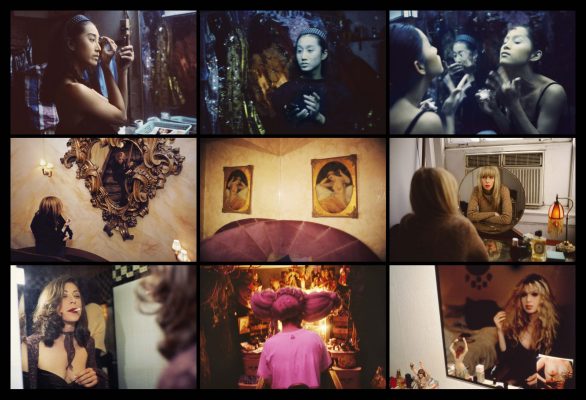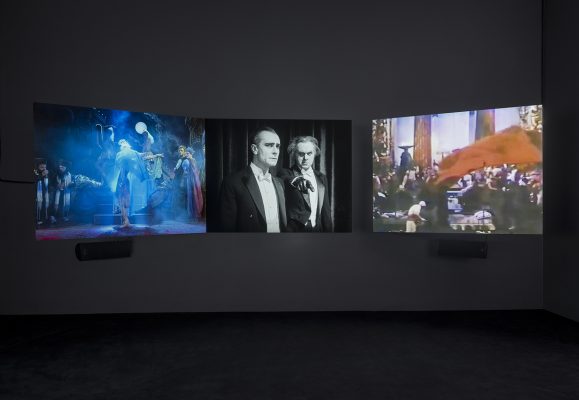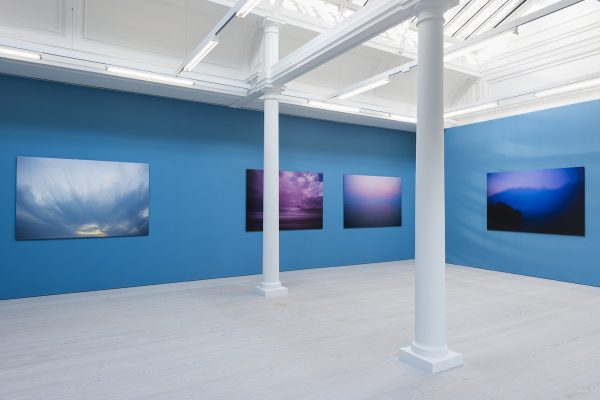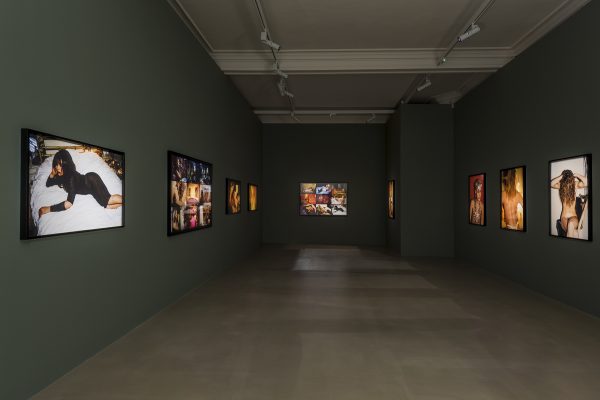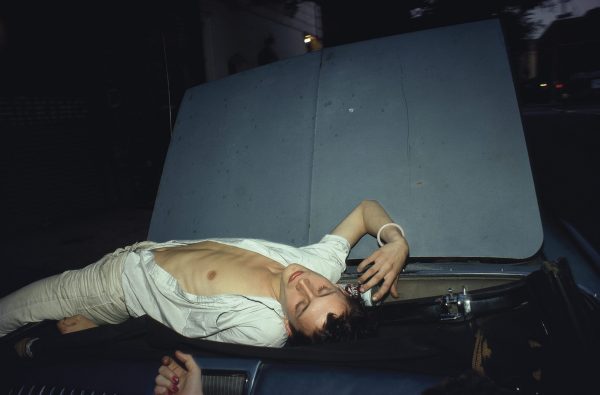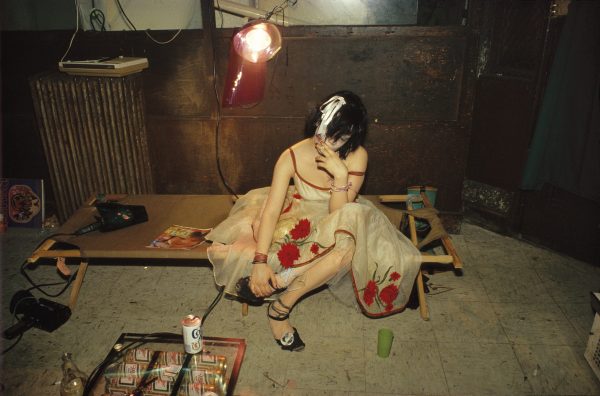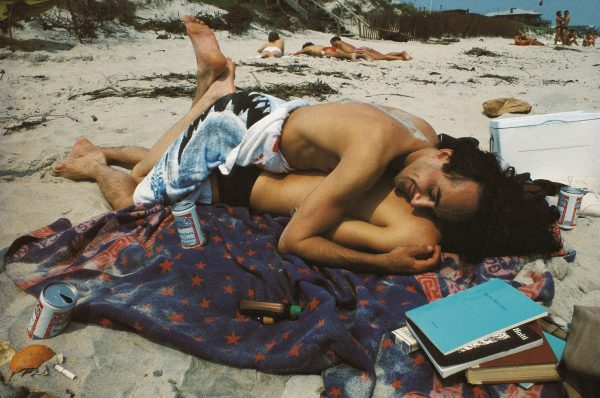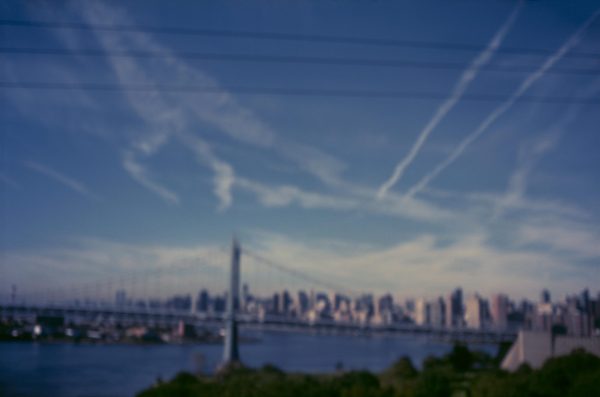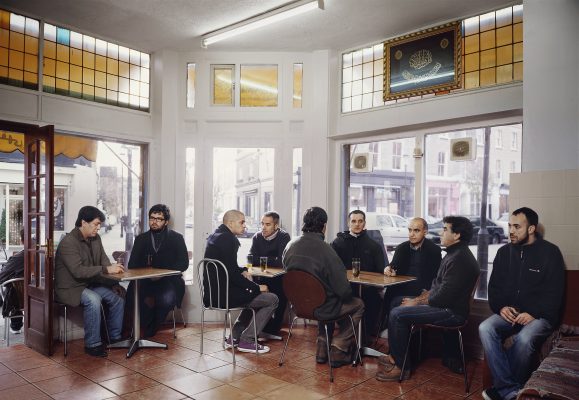The feeling of drug-induced euphoria could be strips of gauze between beautiful fingers. Or a silver slinky sent down a torso by its own muscle, between breasts raised towards God. The perfect face of Donyale Luna, all bush baby eyes and strings of jewels in sunlight. Cigarette smoke sucked back in through dusty lips. The indistinguishable thrusts of dancing or sex or devotion. It could also be the violence of caged dogs, palm leaves dishevelled by storms, a relentless tide and the wreckage of bodies on cracked earth. Composed entirely of found video and dedicated to Luna, a supermodel and actress now forty years dead from heroin, Sirens (2019) is Nan Goldin’s memorial to the act of getting high.
The success of Goldin’s work – its drama, her magnetism – has burdened her over the years with the unhappy credits that are often the risk of influence. In the decade that followed The Ballad of Sexual Dependency (1986), a medley of photos in which the pale and angular people of her life are splayed lawlessly over rooms and each other, then-US-President Bill Clinton accused ‘Dan [sic] Goldin’ of trailblazing ‘heroin chic’. The term came to designate the era’s romance with strung-out, starved depravity. Goldin’s 1996 photographs of sixteen-year-old model James King, taken for a profile in the New York Times Style Magazine, distilled a darkly erotic aesthetic that disturbed as much as it seduced. A junior veteran of drugs, King’s was the questionable glamour of a skinny girl with the face of a child – most beautiful on waking, as a friend reported, when she’s ‘coughing her guts out’.
But just as our culture compulsively points at ringleaders, so does it love a messiah. In recent years Goldin has swung from unholy harbinger of heroin to saviour of America’s opioid crisis. Since early 2019, Goldin’s activist group P.A.I.N. (Prescription Addiction Intervention Now) have repurposed art institutions as stages of dissent against the art world’s taste for Sackler family money – donations from the Pharma moguls known to have deceitfully flogged OxyContin as a safe and ingenious treatment for chronic pain. As we now understand, ‘Oxy’ is neither safe nor new, but a highly addictive variation on an opioid substance that has been tweaked and rebranded repeatedly on each expiration of its patent. In February 2019, P.A.I.N. protesters sent dummy prescription pages whirling down the spiral cavity of the Guggenheim lobby. Printed on these was an email exchange in which Richard Sackler of Purdue Pharma, prior to OxyContin’s launch, wonders how substantially the drug’s likely abuse will improve sales.
P.A.I.N. has made itself known on an operatic scale, resulting in galleries politely declining further ill-gotten funds, the removal of Sackler signage from a wing of the Louvre and a greasing of the wheels of legal prosecutions. Yet despite P.A.I.N.’s sustained denouncement of ‘pills for profit’, any response to its critique of a healthcare system organised around this motive at the expense of public welfare remains to be seen. And despite Goldin’s rage at the social injustices of addiction – its formation of a class within a class, shamed into silent decay – the emergence of an art superstar as a redemptive figurehead, a ‘respectable’ survivor of addiction, has been unselfconsciously celebrated. In an analysis inspired, perhaps, by Harry Potter, Christopher Glazek wrote in Artforum of the epidemic’s origins in ‘actions taken by individuals’, ‘decisions made by a single family’, to be boldly undone by a lone liberator. Goldin’s accomplishment, he writes, ‘shows that it often takes just one brave person who possesses stature within a community to disturb the balance of power’.
So has the media reacted to P.A.I.N.’s activities, relieved to have uncovered the roots and in turn the resolutions of a colossal crisis in the workings of single minds. As though there could be mass deception around drug safety without loose regulation and unrestricted advertising. As though patients could access unchecked volumes of prescription drugs without a private and therefore disconnected selection of available doctors, none of whom are wise to their patients’ collections of scripts. As though there could be corporate greed in medicine without a corporatised system of ‘care’. The problem is clearly systemic, and ranges far beyond the USA. In the UK, where an ostensibly nationalised health service has been subject to creeping privatisation and the shrinking of available provision for pain conditions since the 1980s, around five people a day are now estimated to die from opioid overdose, while the prevalence not only of drug use but of chronic pain itself is neatly correlated in inverse relation to social class.
Many of Goldin’s photographs in recent years are documents of squalor. Dope on My Rug (2016) and Crushing Oxy on My Bed (2015) are portraits of blister packets, boxes and bottles of pills, scattered in the landscape of disorder that was her own addiction to opioid painkillers. In Memory Lost (2019), a digital slideshow shown in alternation with Sirens at Marian Goodman Gallery (November 2019–January 2o2o) – Goldin’s first London show in seventeen years – the artist casts her viewer into the immersive blend of pain that lurks on the flip side of narcotic release. A giant hole burnt into a mattress flashes into view between vomit-coloured hallways and sounds of unrest. Answerphone tapes record voices of dispossession. One man describes never being held as a child. ‘It makes you feel less isolated’, someone says of an unknown substance, amid shots of untouched sand. ‘It’s like mama’s arms’…‘you never feel more secure’. Goldin tunnels down to the absences that lie beneath addiction – the insecurities, the exclusions from community and family, either since the first brush with ‘dope’ or since birth. While her activism has drawn attention to a litany of horrors, her art, which deals with addiction’s origin and experience, is suffused with evidence that giving attention only to the spectacle of death – addiction’s fullest and most dire manifestation – can never be enough.
To sit through Memory Lost while in pain, as I did, is a vigorous trip. At times the depiction of addiction comes uncannily close to the experience of chronic pain itself – the way a party can slide through a red twilight into sickly yellow fog, the way the bodies of others are seen as though in mirrors and through glass. Indeed, there are moments in the piece when no clear distinction is made between the bottomless dive of persistent pain and the vicious cycles of its treatment. ‘I looked at myself’, someone says, ‘and I thought, “I’m going to miss my whole life”’. Having waded through the fug of chronic pain for several years now, I am chilled by this fear most days. It is a situation of anxiety, resentment and troubled relations, where which comes first (the pain or the troubles) is never determined. The pain proves least controllable at times of greatest strain – with any impending commitment or duty for which I am badly resourced, or where someone I love could suffer for my failure. Physical pain is forged in relation to social worlds. While chronic pain may be launched on anyone regardless of their privilege, the demographics most afflicted are those least served by a political system that scorns the disadvantage that it produces, and treats both the value and supposed wellbeing of its citizens as coterminous with their fitness to work. And the greater the need that you swallow down your pain, the more it may dull your vision with ache.
Despite evidence to the contrary, a belief prevails that the source of pain can only be the stuff of wounds and chance bodily malfunctions, easily treatable with bandages and drugs; that rendering a pain visible should, in one tidy gesture, uncover and conquer its source as though eviscerating vampires with light. In medicine, when a physical source cannot be found it is frequently consigned to the realms of malingering or mystery. In response to pain without a visible origin artists have often painted wounds into being – a necklace of thorns stands in for aching bones, a tangle of tubes for a broken heart. Activists in turn will often point to what evidence they see – prescription bottles, death tolls – and ask for restitution. They ride on the tails of a medical tradition that deals in observable damage. Responses in art and protest to the problem of pain often bypass its social dimensions altogether, hence our popular vision of the opioid crisis as a private tussle between wicked and benign individuals. As a consequence, the unseeable causes of pain and addiction often remain low on the agenda.
And so the experience of Memory Lost lands as a balm on my skin even as it jolts the insides. Goldin unravels the whirl of pain, relief and withdrawal and stretches it out across pasts and futures, beyond the realms of mere ‘visibility’ to something that reaches much further. In her book The Undying (2019), Anne Boyer muses on the limits of representing illness. The problem for artists, she says, is that the scene of sickness as shown by its victims ‘would have to be painted on a canvas with no edges, to be too small to measure, to be too large to contain. It would happen outside of time, happen inside of history, exempt the present from the linear, rearrange substance so that blankness is an element, rearrange aesthetics so the negative is almost all’. With Memory Lost Goldin takes the pain/addiction complex and projects its very essence into her audience’s atmosphere. Her video ‘paints’ in the colours of negatives – in the shades of exclusion and the blankness of thwarted desires. As fuzzy shots of skylines and icy roads swerve between monochrome and lurid kitsch, a woman describes how the turning of autumn leaves ‘mocked her’ as she languished indoors. ‘They’re putting apples out’, one man remarks, ‘it must be the Fall’. The white grandeur of a fancy rehab is marred by sickly light, a drooping Christmas tree, a dirty snowman. As I watch footage of the halls of institutions tacked with infantile drawings of ‘Angry’ and ‘Love’, a nasty sense of confinement surfaces – a fear that the authors of these works might never take such feelings out beyond those walls.
As Memory Lost mounts to its conclusion, fire rises from a dancing woman’s underwear and issues from a shirtless man’s mouth. Horizons stretch as the breasts of a woman merge with those of buddhas and classical marbles. Here there is a hint, perhaps, at the starkest negative of all – the vividness that could have been, the sense of beauty or the feeling of ‘alive’ that comes to us fully in Sirens. For most of Memory Lost is a trail of its title’s nothingness. A man recalls looking down on himself in despair and notes that he no longer knows how to cry – ‘he’s just making noises’, he comments, as though speaking of someone else. This, it seems, is the ultimate numbness of ‘dope’; so is it also the hollowness of life in pain. On watching the scene unfold, a sense emerges that narcotic dullness is less a counterpoint to pain than its extension. A sense that both pain and addiction may emerge, whether consciously or not, to displace those emotional pains too large to be reckoned with directly. Many divine that physical pains without end or visible cause must be manifestations of undigested angst. Any scepticism I might have towards such theories wavers in those rare events when the pain momentarily lifts, and what it leaves behind – every time – is a sharpened sense of all life’s troubling vividness. Filling the space that the pain has so persistently occupied, an anxious chaos begins to erupt. It starts with banal concerns around bills but slides without warning to the mental disarray of every possibility, loss, reasonless hope and not-yet-unrequited love. Without pain there is the guilt of wasted time, the weight of ambition. Waking is no longer a dry disappointment but a bleary rush of ecstasy and sorrow. I become aware of the eternity that exists beyond my lifetime. I become afraid of death. Why should a person’s nervous system not demand an end to this crazed irregularity – dull it with pain, dull the pain with painkillers? ‘What a person is looking for in addiction’, says one of Goldin’s voices, ‘is totally sane, totally desirable, totally human’.
‘To be a minor person in great pain’, as Boyer puts it, ‘is to be a person who feels inside their body when most people just want to look.’ Memory Lost places the audience inside the trials of a body in pain, miring viewers in addiction’s fog rather than displaying its outward appearances for their cosy contemplation. This feat of immersion and inclusion has characterised Goldin’s work since its beginnings. In 1986, she spoke of her subjects’ relation to the camera as ‘as much a part of their life as any other aspect of their life with me’. The Ballad of Sexual Dependency was ‘the diary [she] let people read’, a journal expanding with the input of others, a record not of people but the quality of energies between them. ‘It’s almost a collaboration’, she said, ‘it takes on its own life’. In a similar vein the subjects of Memory Lost are credited with having sustained the artist through her full-time grind against addiction, through a time when she felt that she ‘had no skin’. In her own account of addiction’s maw, there is no one devil and no one god. The anti-opioid movement may not yet have found its footing as a stand against something systemic, but Memory Lost, in which voices collide while no single character forms, does a whole lot more than ‘just making noises’.
